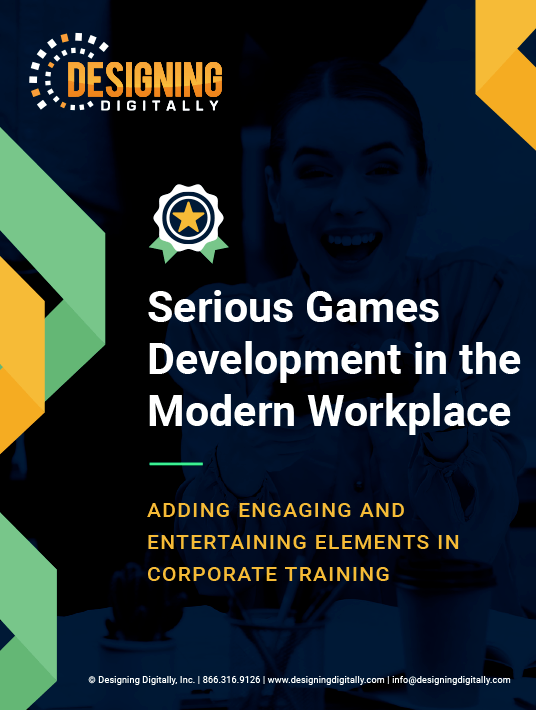How To Successfully Implement Serious Games
Let's face it, people love playing games! Some 2.2 billion people all over the world are using games for fun, to relax, blow off steam, learn new skills, get better at multitasking, etc. Companies have tuned into the fact that most people learn faster and more efficiently through playing. Thus, serious games were born! To talk about serious game implementation, we must first define what serious games are, what they do, and how they can benefit your company's bottom line.

An applied game, otherwise known as a Serious Game, is designed with a more practical purpose. This type of game combines entertainment with education, mostly used for employee training purposes. When done right, serious game implementation can bring employee learning to new levels.
What Are Serious Games?
Serious games can be used in almost any industry. They are popular in:
- Education
- Scientific research
- Military defense
- Politics
- Engineering
- Healthcare
Since infiltrating into corporate training, serious games have grown in popularity. Social media is buzzing about it and companies are adopting serious games into their Learning and Development culture. Virtual reality, Augmented Reality, desktop or mobile applications are all types of platforms on which you can play a serious game. The platform you choose depends on your business and employee needs.
Recruitment, onboarding, and induction procedures, for example, can become more effective through serious game implementation. Companies like IBM, McDonald's, and CISCO have been using game-based learning (GBL) in their employee training strategy successfully. This is because game-based learning (through serious games) combines gameplay and skill acquisition in a fun way.
Users can advance through levels in an engaging way, learn new skills as they play, and acquire knowledge that has immediate on-the-job effects. Each game level needs to be fun and allow the player to follow their own learning curve. If you make GBL a part of your corporate culture, you empower your employees to learn at their own pace. You remove the fear of failure and allow them to create their own learning paths through branching. Branching is a game technique that leads players down different learning paths based on the choices they make throughout the game. At its core, this is a learning-through-doing and learning-through-play method of training.
Applications For Game-Based-Learning
Game-based employee training has many applications and is increasingly being used by various industries. Experiential learning can be used for:
- Employee induction and onboarding
You can use serious games to teach new employees how your sales platform works, how to deal with customer issues or how certain machinery works. - Staff training
You can create learning modules specific to a department to help increase employee productivity and efficiency. - Skill upgrade
Your employees can have access to modules that have immediate on-the-job applications and upgrade their current skills and knowledge. - Personal and professional self-development
This particularly applies to the Millennial generation, who are always looking to learn new things and improve their lifestyle and skill level. - Real-world simulations
By immersing your employees in a real-life simulation, you help them become comfortable with their work environment and remove the pressures of learning and failing on the job.
Serious Benefits Of Serious Games
The benefits of serious games will depend on the type of game, the learning objectives you address, and how much employees enjoy playing. Still, there are quite a few general benefits that apply to most serious game applications.
Productivity Boost
The reason serious games boost productivity is threefold. First, employees can learn new skills quickly and promptly apply these on the job. Second, employees learn through playing. This means that the process is not only educational but also fun and engaging. This learning-through-playing technique speaks to the child inside each of us, thus making it enjoyable and stress-free. Third, this training method can allow employees to learn at their own pace. Making sure the game can be accessed over a few platforms, like mobile and desktop, gives employees the freedom to learn when and where they want. Boosting employee productivity ultimately leads to a more productive business.
High Learner Engagement
Your game needs to strike a balance between pleasure and learning. This will award you the winning ticket to business growth. Make sure that you design your game with employee learning goals in mind. If your employees feel like they are learning essential skills that help their productivity and helps make them more efficient, they will continue to play. Sure, a visually striking design and fun gameplay also contribute to higher levels of engagement. So, make sure the game is appealing to your audience.
Fast Results
Game rewards like badges, scoreboards or public recognition provide instant feedback to employees. It tells them where they are in the training process and where they might need improving. The fact that they can replay any game level is also helpful, as it allows them to go back and learn what they've missed. Including personalized learning paths for each employee is an even more powerful tool. This will allow them to set their own learning goals, gives them specific feedback, and is immediately visible in their job performance.
Remove Fear Of Failure
As mentioned, your employees should be able to go back through the game levels and replay any part where they didn't assimilate important information. Allowing them to fail, retake the level, and maybe even fail again, removes the fear of failure and saves you the trouble of fixing mistakes in the real-world. A simulated environment helps employees feel safe about making mistakes and encourages them to persevere.
Budget-Friendly
Although the startup costs might be on the steep end, investing in serious game implementation can be one of the best decisions for your business. This is because, after the initial research, design, and deployment, your game will last for a while. Current employees can replay it, and new hires will be able to benefit from it for years to come. Depending on the content, you may be able to adapt it to use across multiple departments.
This brings us to the real object of this article: what can you do to successfully implement serious games into your company learning culture? Here are the 7 steps that will guide you in the right direction.
The 7 Steps
1. Surveying Your Employees
The first and most important step is to start a conversation with your employees. Whether through surveys, one-on-one interviews or team meetings, it's important to find out what your employees think about serious games. You'll be able to find out what platform most people prefer playing on, what knowledge and skill gaps they feel they have, and what delivery method they prefer.
2. Choosing The Platform And Design Firm
The next step is choosing the delivery platform for the game. Your employees might prefer to play a desktop game or they might want the mobility of a handheld game. If you want to go all out and really bring in something sensational, you might even opt for VR. It all depends on employee game playing preferences because this will also dictate their level of engagement, knowledge retention capabilities, and on-the-job application.
The game design firm of your choosing will need all this information to create a personalized serious game that fits in with your company goals and employee learning objectives. Make sure you let the design team know you want the game to be flexible, scalable, and include the option of creating personalized learning paths.
3. Keep It Short And Sweet
Now that your game has a wireframe, remember that microlearning is key. Providing short snippets of key information is a lot more efficient than overwhelming the learner with tons of information. Bite-sized modules can focus on teaching a specific skill and have a singular learning objective in mind. Remember that the game needs to teach essential skills and also be fun. So, work with your design team to balance these two out.
4. Planning And Launch
The planning and launch steps depend more on your design and programming team. So, you'll probably be less involved but you still need to be around for guidance. If you give them extensive, well-researched material along with your preferences, this should be enough to get the ball rolling. Good communication is very important to make sure the design team understands how you want your game to look and perform.
5. Gathering Data
One of the greatest benefits of serious games is that you can implement a feedback process throughout. Employees can receive instant feedback after completing each level, and you can gather their results, analyze them, and see where your game might need improvement. This is where personalized learning paths come in. The more you know about your employees' successes or failures with the game, the more you can customize it to help them.
6. Adapting The Game
All that data means nothing if you don't apply the knowledge resulting from it. This is the point where you would take those results and use them to upgrade the game. Doing this will help keep the game engaging and interesting.
7. Repeat
As Stephen Covey says, it's now time to 'sharpen the saw'. Your first pass through this process will yield certain results. You'll need to become as flexible as your game is. So, go back to the beginning, talk to your employees, make the necessary changes, and present the new and improved game. Your game might go through a few passes before it stabilizes and reaches a high level of performance. Perseverance is critical to success, so keep at it! Read the eBook Serious Games Development In The Modern Workplace and learn more about the benefits that are gained with game-based learning.

